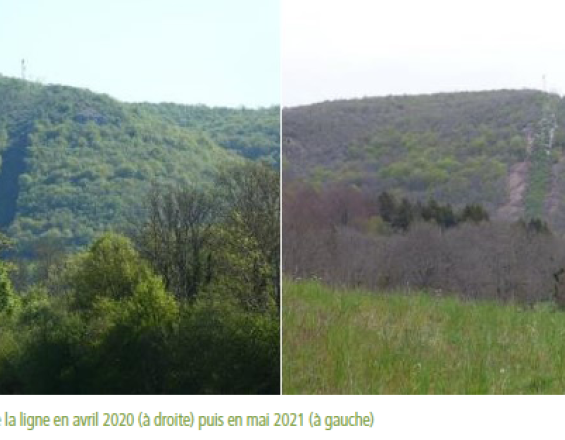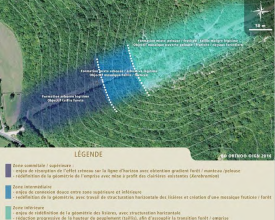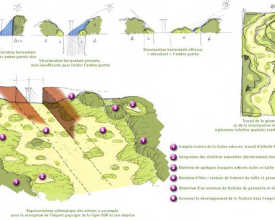Treatment of a landscape black spot, with a dual landscape and ecological vocation

In 2018, the landscape study carried out prior to the renewal of the Val Suzon RNR-FE management plan revealed a number of depreciating features among the factors influencing the landscape. One of the valley's major black spots is the right-of-way for a power line operated by Enedis, which cuts the slope from top to bottom at the valley bend, the site's key landscape hinge. A restoration operation was therefore proposed following the study.
It aims to change the contrasts created by the right-of-way and integrate it into the landscape, taking advantage of the plant and mineral components present. It takes advantage of the slope's ecological gradient: a gradual opening-up in harmony with the site's different natural dynamics, accompanied by a restructuring of the edge at several spatial scales.
The project was carried out in several stages. Following validation of the master plan drawn up by the landscape architect, the work was carried out in 3 successive phases.
Context
Challenges addressed
The work carried out has resolved a social and landscape issue. The Enedis line and its dozen-meter-wide forest right-of-way broke the visual harmony of the valley, and was a real black spot for the listed site. The second challenge was to improve the ecological and functional value of the site, building on what already existed. The newly landscaped edges and shrub strata had a positive effect on all the vegetation on the slope.
We also had to educate our business partner, Enedis, to ensure that the maintenance planned by the latter after the work had been carried out did not call into question the landscaping carried out.
Location
Process
Summary of the process
Landscape diagnosis was a prerequisite for the proposed solution, providing a better understanding of the site's landscape dynamics and classifying the site as a landscape black spot, while proposing an appropriate action plan. The concerted management process resulting from the preparatory phase enabled us to validate the action plan and better plan its implementation in stages.
Building Blocks
Landscape diagnosis and perception
The starting point for the solution: a preliminary study of the landscape component and the black spot was carried out, focusing in particular on all the contrasts with the environment that the power line could create.
Enabling factors
- Knowledge of the site's landscape and ecological structures.
- A 360° view of the landscape from all axes of passage.
- A prior assessment of the landscape as part of the site's challenges.
Lesson learned
By highlighting multiple contrasts, we were able to plan the actions needed to eliminate this black spot and restore harmony.
A concerted management process
The landscape treatment project was the subject of consultation between all the site's stakeholders: the DREAL inspector of the classified site (classified as a landscape under the 1930 law), the RNR-FE curator, the Natura 2000 site coordinator, the commune owning the forest concerned, and the Enedis representatives in charge of maintaining the line and its right-of-way.
The study was submitted to the RNR-FE management committee for approval, and then to the departmental commission for nature, landscapes and sites.
Enabling factors
- Consultation upstream of the various validation processes is essential to the success of the project. It must be based on clear visual elements, such as an intention diagram or drawings.
- In a nature reserve, ecological issues must be taken into account before any action can be taken on the landscape. Demonstrating the added value of the action on the ecology of the site is a major asset for the success of the project.
Lesson learned
For the players regularly involved in the Reserve's actions, there were no difficulties. On the Enedis side, we had difficulty finding contacts. We got round this by asking for the support of a naturalist association that works more regularly with the operator than we do. Networks of players are always essential for mobilizing people.
Implementation in stages
The works were carried out progressively: 3 phases spread over 3 years to achieve the desired structure and respect the ecological dynamics of the site, given that the stations are different according to altitude.
Enabling factors
- A first phase in year 1 concerning the summit part of the site.
- A second phase in year 2 concerning the middle part.
- A third phase in year 3 concerning the lower part.
The cuttings are carried out in a "centrifugal" manner. We start at the edges and gradually move away from them. This ensures that only what is necessary is cut.
The landscape gardener monitors the cuttings "live" from another vantage point, facing the slope, to adjust if necessary.
Lesson learned
It became clear that the presence of the landscape gardener was essential to the successful completion of the work and to the proper application of the original plan.
The results after 3 years are satisfactory, but require long-term monitoring. A posteriori, a photographic observatory of the evolution of the right-of-way should perhaps have been set up for more precise monitoring.
Impacts
Certain anthropogenic infrastructure rights-of-way have been identified as a factor influencing the landscape as a depreciative component. This factor is therefore monitored every year by the Val Suzon RNR-FE manager. The work carried out has reduced the source of visual pollution created by the power line right-of-way. This makes it possible to achieve the target of treating 50% of pollution sources during the life of the management plan.
Beneficiaries
The main beneficiaries were the valley's users and inhabitants , but also Enedis, which saw its maintenance costs reduced thanks to a landscaped, ecological layout that requires more reasoned maintenance.
Story
This project stems from the desire to consider the landscape as a key component of the Val Suzon RNR-FE, a natural site that enjoys a high level of social recognition, thanks in particular to its landscape value and natural heritage. This heritage value is reflected in a convergence of statuses, including the site's classification. The development work carried out and the resulting landscape study are entirely in keeping with this logic. Following the landscaping work carried out, the partner Enedis expressed the wish to transpose the prescriptions laid down under the power line to other forests, with these actions serving as a test for other work in similar contexts - a positive enthusiasm for the continuation of the partnership!



